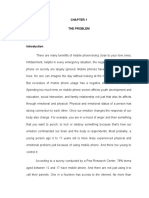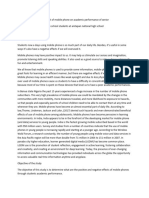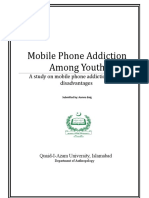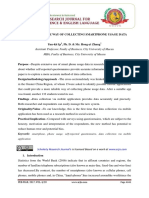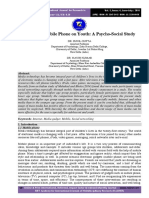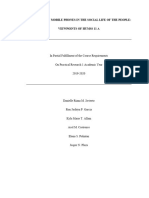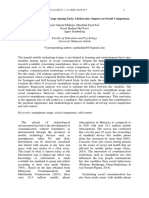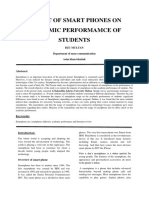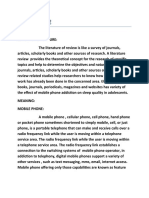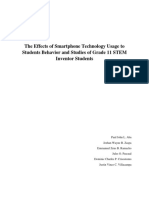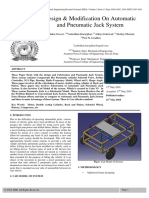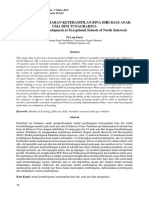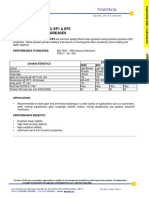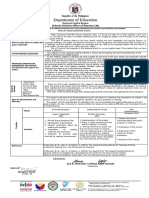Abstract
Mobile phones have become the most well known way to communicate with other people. Whereas cell
phones have become less of a status image and more of a design explanation, they have made an implicit
social reliance. Youths and youthful grown-ups are more likely to lock in in SMS messing, making phone
calls, getting to the web from their phone or playing a portable driven diversion. Once plagued by boredom,
University student resort to moment connection, to somebody, some place. Sensation looking for behavior
has moreover connected youths and youthful grown-ups to have the want to require dangers with
relationships, rules and parts. People look for out excitement and avoid boredom at all times be it suitable or
inappropriate. Cell phones are used for entertainment, data and social network. It has been demonstrated that
people with low self – regard use cell phones to make and keep up social connections. They form an
connection with cell phone which molded their mind that they cannot
Keywords: Mobile Phones, University Going Students, Academic Performance, Learning Skills.
2:Psychological and physical health problem
i
Smartphone habit influences physical and mental health (Abo-Jedi, 2008).). Depression or uneasiness can
cause innovation habit, in that people with depression or uneasiness use smartphone as a adapting strategy to
bargain with depressive and negative feelings (Kim et al., 2015). Smartphone addicts lock in in checking
behavior and react to notice sounds regularly. That's too a characteristic of depression and uneasiness (Cougle
et al., 2012; Evraire and Dozois, 2011A longitudinal think about on heavy clients of a computer, social media,
and portable phone appeared more noteworthy level of drawn out push, discouragement, and rest unsettling
influences (Thomée et al., 2011).. Over the top smartphone utilize at night may keep one awake till late, hence
disabling sleep and affecting stretch and depression (Lemola et al., 2015). Screen time and Web usage were
found to influence
The negative effects of smartphone overuse on physical health include cancer; brain tumor; nervous
disturbances; weakening of the immune system; problems with the eardrum; pain in the wrist, neck, and
joints; fatigue; and sleep disorders (Alasdair and Philips, 2017; Richard, 2001).).
As stated above, the overuse of the smartphone causes health problems, but the deprivation of a smartphone
can also cause health problems. For instance, smartphone addicts were reported to feel distressed when
deprived of their smartphone for some time, and adolescents exhibited anxiety, depression, anger, and sleep
disturbances when their smartphones were switched off off (Assabawy, 2006; Torrecillas, 2007).
Research questions
Q1: Q1:Realationship between changing in behavior and innovation of Smartphone?
Hypothesis
H1: physical health significantly affect the University student’s dependence on smart- phones
�Social influence
Social influence emerges when one person’s feelings, feelings and activities are influenced or impacted by
other i.e. social gather (Artisan, Conrey, & Smith, 2007). D. Lee, Rheeand, and Dunham (2009) identified that
social connection- ships are strongly associated to consumer’s choices to embrace a innovation. Social
impacts come from a assortment of people, such as neighbors, relatives, family individuals, and friends, as
well as motivational figures within the media, such as sports celebrities or motion picture star. Commonly it
is famous that friends and family individuals are the major influencers who influence shopper evalua- tion
whereas selecting a item (Schiffman, Kanuk, & Wisenbut, 2010; Auter, 2007). A few analysts distinguished
social impact as a key develop that impacts both utilization deliberate and utilization behavior, subsequently
they play an im- portant part in customer appropriation of unused innovation (Kulviwat, BrunerII, & Al-
Shuridah, 2009; S. Lee, 2013; Ting, Lim, Patanmacia, Moo, & Ker, 2011).
Literature Review
ii
Aoki and Downes (2004)[3] focused on the behavioral and psychological aspects of cell phone usage among
University students. They tried to find the reasons behind why a technology is adopted in a particular way.
They identified several attitudinal factors based on the exploratory study including, necessity in modern
times, cost efficiency when compared to landline phone, safety or security, and dependency. The study also
endeavored to look at the motivational and behavioral characteristics of mobile phone usage. The authors
tried to combine their results and the result of previous research to find the trends in usage by the youth,
“why college students in the US use the cell phone, what they think of the technology, and how they use it”.
The motivational themes identified by the study include personal safety, financial incentive, information
access, social interaction ,parental contacts ,time management/coordination, dependency, image, and
privacy management. The results of the focus group interviews indicated five distinct user groups in terms
of their attitudes toward their cell phone usage and in terms of the levels of integrating cell phones into
their lives. Aoki and Downs (2002) [3] enumerate the groups as the cost‐conscious group, safety/security
conscious, dependent, sophisticated, and practical users. The cost‐conscious users believe that a mobile
phone helps them save money. The safety/security conscious users are cognizant of their own security and
having a cell phone gives them a feeling of security. The dependent user is a person who is reliant on his/her
phone and feels disconnected to the world without one. The sophisticated users have had their phones for
the longest time and feel it is absolutely a necessity for functioning in the world. The practical user believes
a mobile phone gives cost saving, safety benefits, and time efficiency. This study serves as a valuable
guideline on how questionnaires focusing on mobile phone use may be designed by using focus interviews.
The global nature of mobile technologies makes the cross‐ cultural study of the behavioral characteristics of
mobile phone usage a topic of current interest.
(2004) extensively looked into the rise of the mobile youth in a cross‐cultural perspective. Their stated
hypothesis was that “there is a youth culture that finds in mobile communication an adequate form of
expression and reinforcement.” They indicate that much of the research into this youth culture has focused
on Europe. The researchers cite evidence for the emergence of collective identity resulting from
peer‐grouping based on networked sociability. They examine evidence in the United States where owning a
mobile phone for a teenager has become a rite of passage. This compilation brings up a wide variety of
unique culture attributes for each of the countries or regions studied. However, there is little by the way of
direct cross‐cultural comparison for specific demographic segments.
The literature review shows that the usage of mobile phone technology has a significant societal
influence. The ubiquitous and always‐connected nature of the technology is shaping attitudinal changes
regarding public and private space of mobile phone users. The importance of this area and the study of
the behavioral characteristics involved are being just realized. However relatively few studies are
� available which look at this issue from a cross‐cultural perspective, especially the youth segment of the
mobile phone user market.
influenced multiple aspects of our daily lives, particularly those of young adults. The aim of the current
study, therefore, is to examine how important it is for college students to use and their usage pattern of
cell phone in class rooms, the impact of mobile phone on learning and the effects of mobile phone on
the academic skills acquired age wise and education wise, income wise and by living status. Gender
differences were also examined to provide additional evidence that clarifies current controversial
findings.
Research questions
Q1:Does Social behavior reflect the life of student ?
Hypothesis
H2: Social influence significantly affect the university students’ depen- dence on smart phones
i
https://www.ncbi.nlm.nih.gov/pmc/articles/PMC5802650/#bibr72-2055102918755046
ii
1. Aoki K, Downes EJ. Analysis of young people’s use of and attitudes towards cell phones. Telematics and Informatics
2004; 20(4):349-364.







